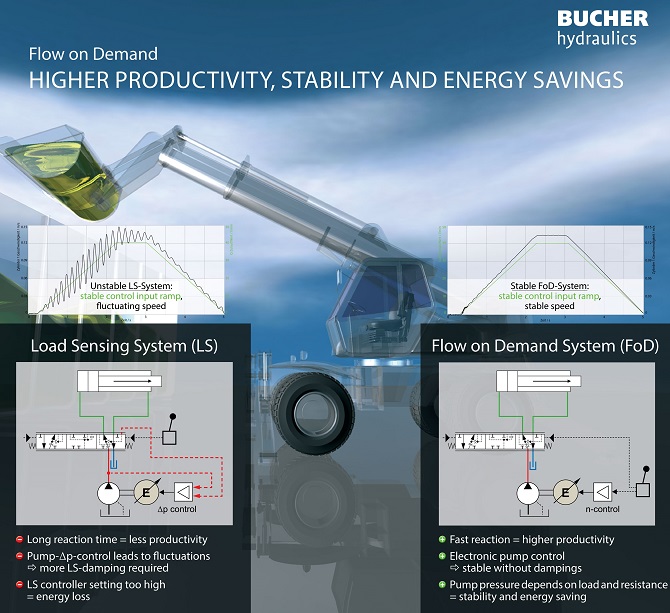Climate-change mitigation and lower CO2 emissions are keen topics of discussion among construction industry OEMs and manufacturers of mobile machines for agriculture, forestry and mining. Which drive systems will be most suitable in the future to meet the demands for high power density and efficient, economical operation with minimal pollutant emissions? Industry expert Dierk Peitsmeyer, Product Portfolio Manager at Bucher Hydraulics in Klettgau, Germany, weighs in on the subject.

Dierk Peitsmeyer
Under what conditions will product planners and designers have to develop mobile and construction machines in the near future?
Peitsmeyer: The reduction in CO2 emissions will have a major impact on technical development in the coming years. The EU with the “Green Label” initiative and the German government with the “Energy Efficiency Strategy 2050” have set the political objectives. To implement the strategy, highly efficient drive systems, alternative drives and hybrids will become increasingly important. All this will also affect mobile machines. Electrification, with energy sources such as battery, fuel cell, or diesel generator requires more-efficient components and systems for precision movements.
This implies that in the future, not only passenger cars but also mobile machinery drives will be hybrid or even fully electric, for example, in earthmoving, forestry and agricultural applications. What do operators essentially demand from these “alternatively” driven machines?
Peitsmeyer: An important factor is undoubtedly a sufficiently long service life without recharging the batteries, which takes a lot of time. Besides, the operators naturally keep an eye on the economic operation. They expect low costs and little effort in energy consumption, maintenance, service, and repair. In addition, alternatively driven machines must also function very reliably and maintenance-free over long periods of time. Only then can the company operate economically and profitably.
Another aspect related to environmental protection is definitely noise emission. Mobile machines should be as quiet as possible. It will certainly be crucial that the machines are at least up to the usual standard or better for daily operation and acceptance of the operator. To achieve high performance, short reaction times are of vital importance when controlling the functions.
What options are available to meet these requirements?
Peitsmeyer: Sufficient operating time can be achieved with a physically large energy source or low power dissipation. However, a large battery or fuel cell is relatively expensive. Efficient components and an effective system can prove to be a more sensible approach depending on the load spectrum, as the energy costs are also lower. Electric drives already offer high efficiency over a wide operating range. Nevertheless, the hydraulics used today in mobile machines powered by diesel engines are not efficient enough.
Load sensing (LS) systems with variable-displacement pumps do not optimally meet the criteria for electrified machines. The noise emissions of conventional variable-displacement axial piston pumps are too high. They will be particularly prominent in electrified machines due to the absence of diesel engine noise. The level of efficiency is not optimal throughout the entire operating range. The LS control deviation causes unnecessary losses in most operating points. Significant damping is occasionally necessary to operate the LS system without oscillation. This extends the response time considerably.

Comparing load sensing and flow on demand systems.
Consequently, it is not advantageous to replace the diesel engine with an electric motor and leave the existing hydraulic system unchanged. Replacing hydraulic cylinders with electromechanical linear drives has proven to be impractical. Mechanical gearboxes are not suitable for the high loads of a construction machine. Furthermore, every electromechanical linear drive requires an electric motor with correspondingly high power. As a result, the installed power is relatively high, even though it is never driven simultaneously. An optimized hydraulic system is a compromise between efficiency and cost. For high-performance functions with a high energy recovery potential, closed-circuit displacer controls are an excellent choice. They have the lowest losses. Each linear function requires a combination of electric motor and pump, comparable to electromechanical linear drives. It does not make sense for all functions.
Therefore, you consider the technical options shown to be insufficient or a compromise where you have to accept too many restrictions. What alternatives are there to better meet the partly contradictory demands?
Peitsmeyer: For precision movements, valve controls with “Flow on Demand” (FoD) are an economical alternative. Hydraulic control blocks with separate control edges, such as the LVS12 from Bucher Hydraulics, reduce power loss and enable movements that are more dynamic; therefore, the effectiveness of the machine further increases. It is possible to combine variants of electric drives and hydraulic systems optimally in an electrical system with a dc intermediate circuit.
The pump operates as a fixed-clearance pump with variable speed. Electric motor speed is calculated by the Bucher Hydraulics FoD software using the valve actuation characteristics. The control pressure difference required in an LS system is eliminated. The result of the FoD system is always the lowest possible pressure at the pump. It depends on the current load and pressure losses, the latter which can be minimized by an optimized system design.
In the FoD system, the valve opening and pump speed are controlled simultaneously. As a result, the responding behavior is very fast and direct, comparable to the performance of electric travel drives. The control system is stable without oscillations. This allows the operator to drive the machine more effectively. FoD also offers additional advantages for controlled functions, such as assistance control systems. Our FoD software features additional options that are not available with a traditional LS system.
This certainly requires a much greater effort for control technology as well as hardware and software development by the machine manufacturer. To what extent are hydraulics manufacturers able to offer economic solutions in this area?
Peitsmeyer: With Bucher Hydraulics’ FoD software, the user has no trouble generating the optimal electric motor speed. In variable-speed operation, the pump is of particular importance to meet the specific requirements of mobile hydraulics. The pump is the heart of the system. Comparable to the efficiency of high-quality electric motors, it must run at 92 to 94% efficiency over a wide operating range. This minimizes the need for costly battery capacity. There is a significant difference whether 5 kW or only 2.5 kW power loss is generated by the pump. The efficiency chain further enhances this effect.
Consider the Bucher Hydraulics AX pumps. Even at high performance, noise level is low and pleasant, as expected by end users. The AX pumps can be started at high pressure and operated at very low speed without premature and excessive wear. Due to low leakage and the high number of pistons, smooth cylinder movement can be achieved even at low speeds. This is advantageous for precise positioning or when large booms are involved. The design principle with consistent hydrostatic relief of the components makes these pumps particularly reliable. With AX pumps and FoD software, hydraulic systems can perfectly meet the requirements of electrified machines and, thus, make a vital contribution to the future economical and productive use of electrified machines.
Bucher Hydraulics
www.bucherhydraulics.com
Filed Under: Mobile Hydraulic Tips